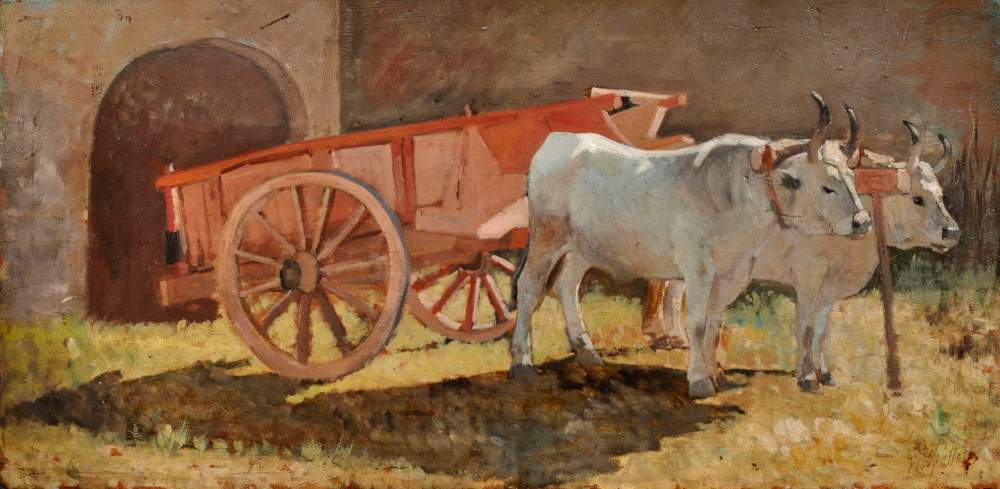From December 16, 2022 to May 1, 2023, Palazzo Fava, the Palazzo delle Esposizioni of Genus Bononiae. Museums in the Cities of Bologna celebrates Giovanni Fattori with a new exhibition project. Fattori. Humanity Translated into Painting, this is the title of the exhibition curated by Claudia Fulgheri, Elisabetta Matteucci and Francesca Panconi and realized in collaboration with theMatteucci Institute, will offer a selection of more than seventy works by Giovanni Fattori. The exhibition intends to focus on sentiment as a fundamental element of Fattori’s painting, visible in portraiture as in landscapes, in paintings of rural subjects as in the great canvases of the Risorgimento: a painting capable of expressing the truest humanity and the deepest emotions.
More than fifty years have passed since the last exhibition presented in Bologna on the great master from Livorno: as studies have progressed, interest in the Macchiaioli has grown more and more, also due to the important reviews that have seen the Tuscan movement at the center. The exhibition project at Palazzo Fava intends to restore, through a temporal and thematic excursus in the author’s wide-ranging production, his view of existence, revealing the unconscious poetry inherent in it, despite everything. In this ability to “liberate” the essence of the transitory, fixing it in the different pictorial genres with which the painter dealt, lies Fattori’s modernity, understood as the ability to grasp theimmutability of human feeling, the eternity behind contingency.
“The renewed attention to the Macchiaioli is confirmed not only by the vast bibliography devoted to them from the postwar period to the present, but also by the interest shown in their painting by foreign museum institutions,” the curators stressed. “This is what emerged in the planning stages of an exhibition within which stand out authentic milestones worthy of the most prestigious public placements. Precisely in the opportunity to lift the veil on them consists the most attractive element of the exhibition, returning a Fattori, if we can say so, ’private,’ less known and investigated.”
The entire creative evolution of Fattori’s painting will be presented in the exhibition through thematic nuclei-The Macchia: Birth of a New Art, The Military Theme as a Document of History and Contemporary Life, The Other Face of the Soul, Castiglioncello, “remote and delightful site,” The Intimate Perception of His Own Time, The Light of Truth, a Life-giving Element, and The Animals, Friendly, Powerful and Peaceful Creatures: from early research on the stain applied to the documentation of Risorgimento war events, with masterpieces such as French Soldiers of ’59, in which the silhouettes of soldiers are resolved into pure patches of color in the landscape, Military Post at the Camp and the previously unpublished In marcia.
In the ’portraits of the soul,’ painted between 1861 and the early twentieth century, introspective sensibility is combined with marked Tuscan-style realism. Particularly significant is the series of portraits of friends and relatives, which, as direct witnesses of passages from the painter’s life, reveal the most intimate aspects and social stratum of his world: among them, I fidanzati of 1861, which restore the physiognomies of the models, cousin Argia Bongiovanni and Valfredo Carducci, Giosuè’s brother. No less evocative are the portraits from the 1980s and 1990s, including the solemn buttero, The Red Shawl, Sea Wolf and Old Sailor. In the latter, the sober and elegant vocabulary of the interior depictions is abandoned, while the essence of the subject’s personality emerges powerfully from the neutrality of the background. And again the landscape studies of the Castiglioncello season, an oasis of peace that welcomed him upon the death of his beloved wife Settimia Vannucci and restored his creative impetus, and the careful and nostalgic narration of the transformations of the urban fabric of Florence, among roofs, carriages and barrocciai, the marine views such as Mare azzurro, La Punta del Romito and La Punta del Romito with boats and fishermen. Dates back to the late 1980s the encounter with the primal vitality of the Maremma, where the painter grasps, in the symbiosis between man and animal, the trace of his own soul at once forthright and genuine. An encounter that gave new impetus to his creativity, with masterpieces such as La mena in Maremma or the lyrical Viale con buoi e spaccapietre, presented to international critics in the 1876 International Exhibition in Philadelphia.
Accompanying the exhibition is the catalog, published by Skira Editore and edited by Claudia Fulgheri, Elisabetta Matteucci and Francesca Panconi: a rich iconographic apparatus documents the figure of Fattori in every aspect. The preface bears the signature of Pupi Avati, who with veiled nostalgia recalls an episode from his childhood, when the death of his father forced his family to deprive itself of a painting by Fattori, considered the most important piece in the collection assembled by his parents. The “hole in the wall” left by the painting, a mute witness of mourning, becomes the pretext for revealing the link between the director and Fattori’s art, the result of an obsession “of one who endlessly besieges the same images trying to extract the secret, as Pavese did when writing about the hills of his childhood.”
For info: https://genusbononiae.it/palazzi/palazzo-fava/
Image: Giovanni Fattori, Bovi al carro
 |
| Bologna celebrates Giovanni Fattori with an exhibition, after more than 50 years |
Warning: the translation into English of the original Italian article was created using automatic tools. We undertake to review all articles, but we do not guarantee the total absence of inaccuracies in the translation due to the program. You can find the original by clicking on the ITA button. If you find any mistake,please contact us.